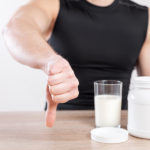By Bonnie Jenkins, Advanced Natural Wellness
Are you getting enough protein? If you said yes, you may be wrong. According to a new study, you just might need twice the amount recommended by the 2005 Dietary Guidelines for Americans. The current U.S. recommendation states that adults should consume between 10 and 35 percent of their calories from protein. The problem is, these protein recommendations were established with the goal of preventing deficiency. That doesn’t necessarily mean that these amounts are optimum for our health.
This powerhouse nutrient supplies the building blocks needed for the growth and repair of body tissues. In fact, protein is part of every single cell and makes up the body’s structural elements like the skin, nails, muscles, teeth, bones and organs. But it’s benefits don’t stop there. Protein provides enzymes and key hormones, enables nerve and brain cells to effectively communicate with one another, and helps the body resist disease by regulating antibodies. It also moves needed nutrients into and out of your cells and around your body. Bottom line: Without protein, life would cease to exist.
But, it’s not just the amount of protein you eat that matters. It’s also the type of protein you consume. Complete protein, like that found in lean meats, fish, poultry, eggs, dairy products and soy, provides ample amounts of all nine of the essential amino acids. Complete protein is also the most easily absorbed. Incomplete proteins, like those in beans, legumes, grains and other plant foods, contain limited amino acids and are not absorbed as well as complete protein. Fortunately, eating a variety of complete and incomplete proteins each day can give your body all of the essential amino acids it needs. You can also combine two or more incomplete proteins—such as navy bean soup and whole grain bread, lentil curry and brown rice or even peanut butter on whole wheat toast—to form a complete protein.
Protein is most readily absorbed in an acidic environment. This means you need to have sufficient stomach acid to uncoil the protein strands so that the digestive enzymes can break them down into smaller molecules. You can enhance this process with supplemental digestive enzymes. Because your body’s enzyme production drops off after you hit age 30, it’s smart to add an enzyme supplement that specifically targets protein digestion. Known as proteolytic enzymes, these include papain from papaya and bromelain from pineapple stems. You can find these supplemental enzymes as either stand-alone supplements or as part of some supplemental protein powders. If you opt for a separate enzyme supplement, make sure to take it with food for best results.
So what’s the best way to boost your protein intake? Start by increasing the amount of protein in your diet. Just make sure you opt for lean protein like chicken breast, fatty fish (think salmon) or tofu. Adding beans, lentils, nuts and low-fat dairy can also increase the amount of quality protein you eat.
Are You Suffering From...
- Love handles and a pot belly
- Romance that isn't what it used to
- Forgetfulness and inattention
- Low (or no) strength and endurance
- A sex drive that's shifted into neutral...or worse
If so...you may have Mature Male Burnout. Click here to discover more about this unique condition and what you can do about it.
If you exercise regularly or are very active, you need even more protein. That’s when you want to consider a low-calorie protein supplement. Adding protein powders and bars to your diet can provide both convenience and a concentrated source of this vital nutrient. Protein supplements are typically made from egg whites, milk (casein or whey) or soy. Don’t eat meat or dairy? You can also find vegan sources from hemp seed, rice or pea protein. While these are adequate alternatives, they aren’t as readily absorbed as, say, whey protein isolate.
You don’t need to be a body builder to benefit from protein powders or bars. Used judiciously, adding a scoop of protein powder or noshing on a low-calorie protein bar can add some heft to your nutritional intake and keep you going strong every day.
References:
Boyle MA. Personal Nutrition. Wadsworth Cengage Learning. Belmont, CA. 2007.
Grover Z. Protein energy malnutrition. Pediatric Clinics of North America. 2009;56:1055-1068.
Rodriguez NR. Position of the American Dietetic Association, Dietitians of Canada, and the American College of Sports Medicine: Nutrition and athletic performance. Journal of the American Dietetic Assocication. 2009;109:509-527






